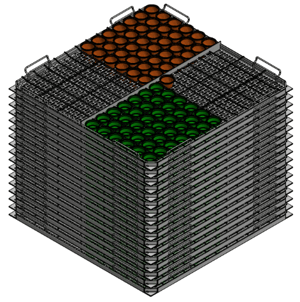 One of the biggest challenges in designing food processing equipment is ensuring that said equipment is able to withstand the stresses of the food making process. Some food products have to sit and cure for weeks at a time before they’re ready. Take, for example, olives.
One of the biggest challenges in designing food processing equipment is ensuring that said equipment is able to withstand the stresses of the food making process. Some food products have to sit and cure for weeks at a time before they’re ready. Take, for example, olives.
A client approached Marlin Steel for a custom wire basket for their olive processing needs—one that could safely hold a large number of olives for over two months as they cured/fermented. These olives had to be protected from impacts that could break them, but also be easy to reach so they could be pitted. Additionally, once the fermentation process was completed, the olives would be heat sterilized to keep them from going bad.
The curing process for the olives prominently featured the use of sea salt and water—a combination that can be highly damaging to plain steel. Meanwhile, the high temperatures of the pasteurization process negated the idea of using plastic polymer baskets—they’d melt under the oven-like conditions.
Storage space in the curing facility was at a premium, so the client needed a way to store a lot of olives in as small a space as possible while they cured. The olives themselves would be held in small cups within each basket (to prevent one diseased/bad olive from negatively impacting too many others at once). With the cups, olives, and brine, each basket would have to hold a surprising amount of weight.
So, how did Marlin’s degreed engineers build the perfect olive processing basket to meet this client’s needs? Here’s how:
Taking into Account the Olive Processing Method
The design team began the custom basket design process by getting some details from the client—what the baskets would be used for, what kind of chemicals/temperatures they’d be exposed to, and any special requirements the client needed fulfilled. After learning about the salt solution, the two-month curing process, the olive cups, and the need to save as much space as possible, Marlin Steel’s degreed engineers decided to make a stackable stainless steel wire basket.
The stacking feature would let the client place numerous olive processing baskets on top of one another, saving space in the curing facility. The stainless steel would help the baskets withstand occasional exposure to the salt-rich brine used to cure the olives. The fact that the basket used a set of thin wires would help to maximize air flow so the curing process could proceed uninterrupted.
A divider was added to the design to help sort the olive products in each basket, and to keep the cups from sliding around too much during handling. Numerous small handles around the edges of the basket would make it easier to carry—as well as keep stacked baskets from sliding around.
After creating a food processing basket design based on the client’s responses to the custom basket questionnaire, Marlin’s engineering team started running the design through a finite element analysis (FEA) software to identify any potential flaws.
Rapidly Iterating the Custom Olive Processing Basket
The FEA testing revealed a critical flaw in the olive processing basket design. Namely, when fully-loaded baskets were stacked more than a few units high, the intense pressure could cause the thinner basket wires to bend slightly. Over time, this could compromise the basket.
At first, Marlin’s degreed engineers considered using thicker wires to compensate. But, even thicker wires wouldn’t be able to be welded securely enough to guarantee that the baskets could withstand being stacked as high as the client needed. So, in a later design revision, the bottom of the basket was supplemented with a sheet of laser-cut perforated sheet metal.
This would allow for a larger, stronger weld connection with the wire frame, increasing the overall rigidity and strength of the basket under heavy loads. In turn, this allowed the baskets to be stacked high even when fully loaded, helping to save space.
Normally, such testing would take weeks and require the waste of many prototype baskets. However, with FEA software, the design could be put through a physics simulation in mere seconds. This meant no waiting for (or wasting money on) tooling and exhaustive physical testing for each round of prototypes.
Instead, Marlin’s degreed engineers could plug the design specs from the CAD file into the software, hit start, and know in seconds whether the design would pass or fail. And, each time the design failed, the reasons why would be reported to the designer so that the design could be reworked. This process of design, testing, and iteration only took a day or two to create the perfect olive processing basket design—despite going through nearly a dozen revisions.
Once the design was finalized, the baskets were assembled right away in Marlin’s Baltimore-based factory using advanced manufacturing automation tools, including numerous wire bending and welding robots—as well as a Trumpf laser cutting machine to cut the sheet metal plates.
Between Marlin’s super-fast design iteration process, robotic manufacturing capabilities, and U.S.-based factory location, the client was able to go from initial design request to a delivered product in a fraction of the time it would have taken a foreign-made equivalent to arrive.
Need a custom food processing basket for a special task delivered fast? Contact the experts at Marlin Steel to review your custom basket needs.



.gif)


